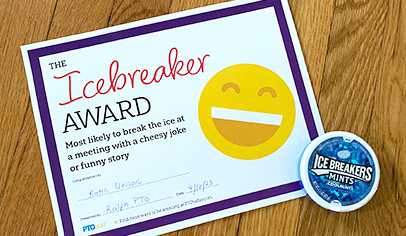Communication between PTO leaders typically involves a lot of phone calls and periodic face-to-face meetings. Today’s technology gives us a new option. More and more people are using email as one of their primary communication tools for daily life. It’s fast, it’s cheap, and it’s easy.
With the growing status of email, there are times when it’s a suitable, maybe even preferable, way to communicate. But be aware that there are situations when email can be overused or misused, causing more trouble than you might expect. So before you cancel all your in-person board meetings and replace them with email conferencing, consider all the angles.
Establish a board protocol for email use. Specifically, find out how comfortable each board member is with email. Some may be proficient users, some novices willing to learn, some resistant but resigned to the reality that email is the wave of the future; others may not have access to a computer at all.
Decide as a group how and when email will be used to conduct board business. For example, you may all agree that the approved executive board minutes can be distributed via email. The same consideration should be extended to your committee chairpeople. If your board talks about email usage up front, you avoid communication problems down the road.
And if you personally don’t intend to check your email account regularly, don’t hand out your email address. Better to rely solely on traditional communication like telephone calls than to risk causing frustration among your fellow officers when they feel you’re disconnected.
Be aware of the limits to email efficiency. Because it’s electronic, email feels lightning-fast. But as a group communication tool, it’s often painfully slow and inefficient. People check email at their convenience—anything from several times a day or late into the night to only once or twice a week (or even less). You might be sitting anxiously at your computer, expecting to hear the beep of a new email, but your fellow officers might be at the grocery store, helping out at school, or at work without email access. Rather than waiting for a reply, maybe even growing impatient, pick up the phone if you need an answer within a certain amount of time.
Don’t use email to brainstorm new ideas. By its very definition, brainstorming relies on the active sharing of ideas between people in a group setting. One person offers a suggestion, which can spark the creativity of another participant and lead to an even better idea. With email, no one has the benefit of the energy that comes from group conversation. Any parent group issue that relies on creativity or synergy should be saved for a face-to-face meeting. For example, if your board needs to develop a new fundraising strategy, plan the meeting date and time by email, but save the real work for when you’re all gathered in person.
Never argue by email. Save discussions, especially on controversial topics, for when the group is together. Remember that with email, there’s no benefit of voice inflection, facial expression, body language, or the dynamic exchange that you have in a face-to-face setting. Not everyone is skilled at voicing their opinions and ideas in text. It’s possible to “say” more than you should in hopes that you’ll preempt subsequent questions. But sometimes those unnecessary words cause more trouble than they avoid.
Even an innocent-sounding comment or question can kick off a long series of confusing email exchanges. For example, in planning your PTO’s first-ever silent auction, you might wonder how your fellow officers feel about requiring the teachers to coordinate classroom baskets. You send a short email to the group for their opinions and expect short replies. But if you’ve inadvertently sparked controversy, you might be surprised by the tone of individual responses. In an effort to quell the tension, you reply to everyone who got the original message so they can keep up with your latest comments.
Before long, the readers lose track of who said what and who is replying to whom. You’ve written something you really don’t need others on the list to read. And you clutter your officers’ mailboxes with unnecessary messages. At this point, it’s best to end the email exchange and add the item to the agenda for your next board meeting.
Don’t include extraneous recipients in your distribution list. Email’s effectiveness can get bogged down when the distribution list includes too many casual observers. If your topic is staff appreciation, you don’t need to include all the committee chairpeople on the email list. Think carefully before you add additional recipients.
Don’t vote via email. No matter how clear you are that the appropriate response is a simple vote between a number of discrete options, voters will inevitably reply with multiple selections, accompanied by several caveats and disclaimers. All you expect is a simple yes or no, but you’ll get a lot of maybes.
Don’t seek document revisions from a group via email. Today, PTO documents like bylaws, meeting minutes, and newsletters are produced electronically. It might seem logical to revise these documents with email feedback from committee members. For instance, when the chairwoman of the bylaws committee is ready to distribute the first draft to her fellow committee members, she sends it by email and asks for comments. Each committee member sends back her individual revisions in isolation.
Unfortunately, the chairwoman now has to consolidate all the separate comments into one version. Some of the individual comments might even contradict one another. She does the best she can, sends out the next version, and hopes the committee members will be in agreement. Since the committee members didn’t have the benefit of hearing the comments as a group, each can only respond based on her individual perspective. A far more efficient approach would be for the bylaws chairwoman to send out only the original document by email, then for the group to meet in person to share, debate, and refine their suggestions.
Email can be a valuable tool for a PTO executive board. Just remember that it’s most suitable for disseminating basic information or reference materials, for one-way communication, and for one-to-one dialogue. Use it to confirm a previously scheduled date. It’s perfect for distributing the agenda in advance of a meeting, or sending the approved minutes after a meeting. Or ask a simple question of another member if she’s the only one you need a response from.
If the topic requires feedback from the executive board as a whole (or any other large group), save it for your next face-to-face gathering. And don’t dismiss the power of the personal touch—sometimes, communicating by phone call or casual chat is the best way of all.
Email Best Practice
While email is an excellent and inexpensive method to communicate with parents and the community, it's important to follow the ever-changing laws relating to privacy, spam, and email communications in general.
The simplest advice is to develop an "opt-in" approach if you use email or other electronic communications: Seek permission first before sending. Then honor any requests to be removed from the list and avoid future communications.

























